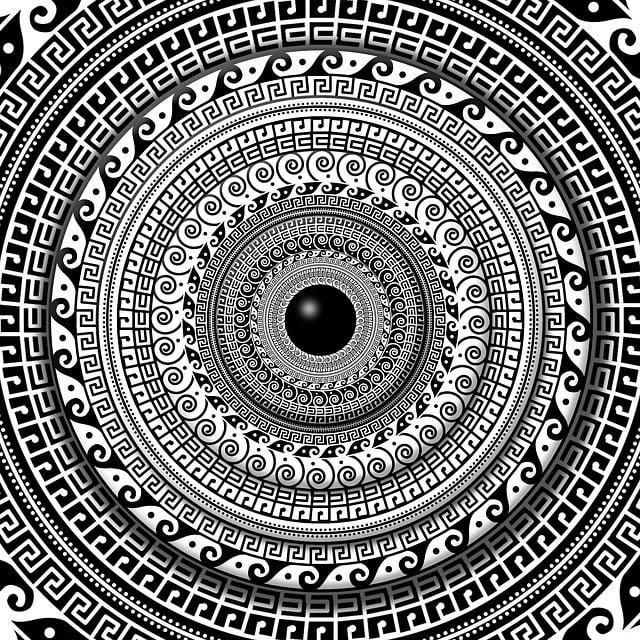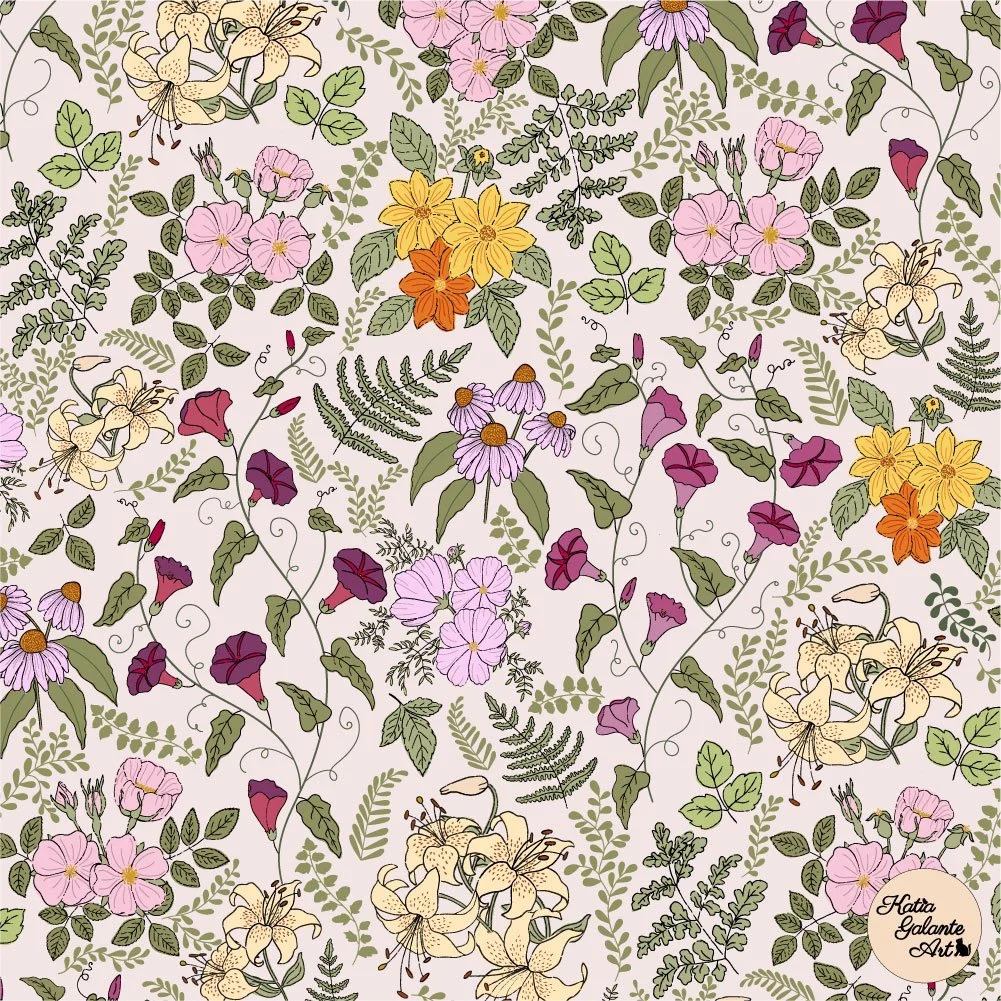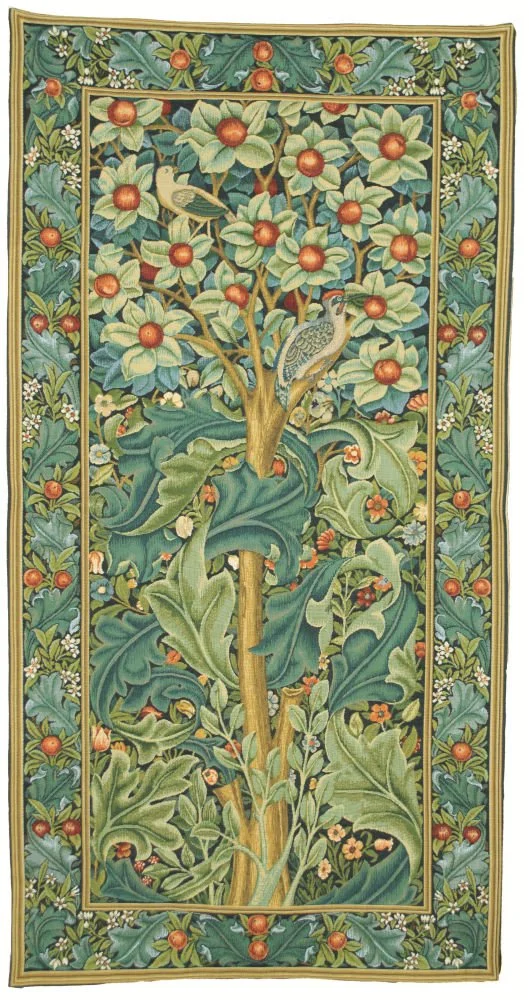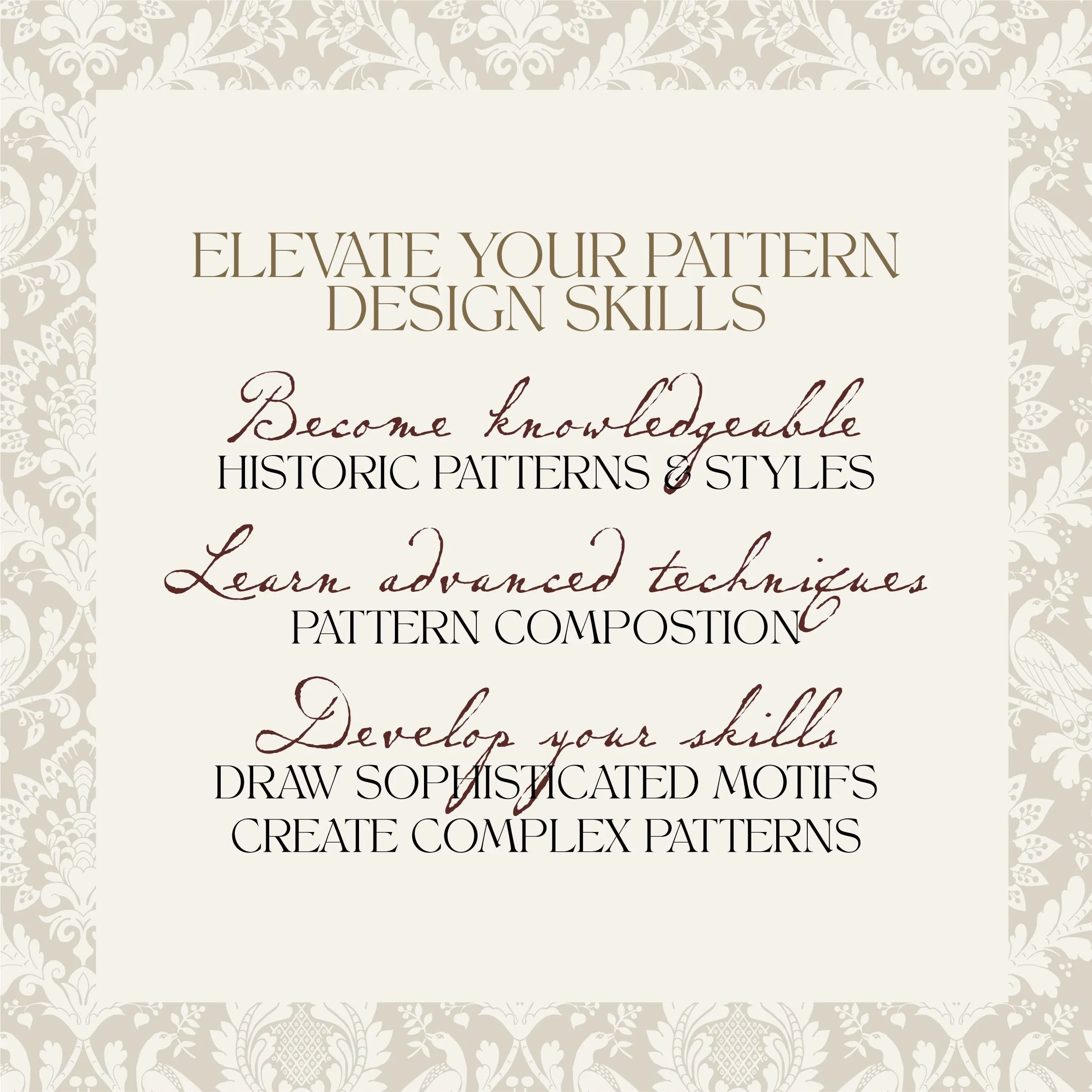Introduction
Patterns have been an essential part of human culture for centuries, serving as a means of communication, decoration, and artistic expression. Throughout history, different civilizations and cultures have developed unique patterns that reflect their values, beliefs, and aesthetics. From intricate mosaics in ancient Rome to delicate Chinese porcelain, the world is a tapestry woven with diverse historical patterns. In this blog, we'll delve into the enchanting world of historical pattern design, exploring various types of patterns and shining a spotlight on the influential work of William Morris. Plus, we'll introduce an exciting opportunity to learn how to create historical patterns through the Repertoire course and a very exciting licensing opportunity!
Diverse Types of Historical Patterns
Historical patterns encompass a wide range of designs that have evolved over the ages. Some of the most notable types include:
image from Pixabay
Geometric Patterns: A Symphony of Symmetry and Mathematical Elegance
Geometric Patterns are a celebration of symmetry, a visual representation of the mathematical order that pervades the natural world. From the elaborate tessellations of Islamic art's zellige tiles to the mesmerizing mosaics of ancient Greece and Rome, these patterns captivate the eye with their intricate interplay of shapes. Symmetry in geometric patterns is a testament to the precision and balance that humanity has sought to capture in both art and science.
Cultural Significance:
These patterns have transcended cultural boundaries, weaving a common thread that connects civilizations separated by time and geography. The geometric elegance of Islamic architecture, with its precise repetition of motifs, reflects the mathematical and spiritual pursuits of the culture. In ancient cultures, geometric patterns adorned architectural marvels, from temples to palaces, where symmetry was not just an aesthetic choice but a reflection of the order and balance revered by those societies.
Beyond Aesthetics:
While geometric patterns are undoubtedly visually striking, they often hold deeper significance. Many ancient cultures believed that these patterns held spiritual and mystical meanings, with certain shapes and combinations believed to bring protection, luck, or harmony. The inherent balance of these patterns also resonates with the human psyche, evoking a sense of order that soothes the mind and inspires contemplation.
My own take on geometric patterns
Modern Influence:
The allure of geometric patterns continues to inspire modern design, from architecture to fashion. Minimalist interiors often feature clean lines and geometric forms, while contemporary art plays with repetition and symmetry to create visually engaging experiences. In technology and science, geometric principles shape everything from computer graphics to the foundations of quantum mechanics, showcasing the enduring relevance of these patterns in various disciplines.
A Universal Language of Beauty
Geometric patterns are more than the sum of their shapes; they are a universal language of beauty, balance, and order that has spoken to humanity throughout the ages. As we gaze upon these intricate designs, we are invited to delve into the mathematical mysteries that underpin the universe while appreciating the cultural diversity they have adorned. Geometric patterns are a testament to the human quest for meaning and aesthetic harmony, a symphony of symmetry that continues to captivate and inspire us to this day.
Image by Katia Galante
Floral Patterns: A Celebration of Nature's Beauty and Symbolism
Floral patterns are a timeless testament to the enduring beauty of the natural world. They capture the essence of blooming flowers, dancing petals, and lush foliage, freezing moments of growth and vitality in patterns that live on through generations. These designs are more than artistic embellishments; they are a tribute to the cycles of life, renewal, and the harmony found in the ecosystems that sustain us.
Cultural Reflections:
From the intricate lotus motifs in Indian textiles to the romantic roses of European decor, floral patterns have woven their way into the cultural tapestries of societies across the globe. Each culture infuses its own symbolism and meaning into these designs. In ancient civilizations, flowers were often imbued with spiritual significance, representing qualities such as purity, beauty, and love. These cultural reflections continue to resonate with us today, inviting us to explore the nuanced connections between art, nature, and human emotion.
Narratives in Blooms:
Beyond their aesthetic appeal, floral patterns often tell stories. In Eastern cultures, the cherry blossom carries connotations of fleeting beauty, a reminder of the impermanence of life. In the Victorian era, the language of flowers communicated sentiments that words could not express. Bouquets of flowers held coded messages, allowing individuals to convey emotions discreetly. Floral patterns become a medium through which narratives are expressed, connecting us to the stories of those who lived before us.
Modern Interpretations:
Midsummer Dreams by Katia Galante
Contemporary designers continue to find inspiration in floral patterns, reimagining their forms in innovative ways. Fashion runways showcase garments adorned with vivid blooms, while interior design embraces floral motifs to bring a sense of nature indoors. Artists combine the organic beauty of flowers with abstract elements, creating patterns that evoke emotions beyond what the eye can see. These modern interpretations breathe new life into floral patterns, ensuring their relevance in our ever-evolving world.
A Blossoming Connection
Floral patterns are more than mere designs; they are bridges that connect us to the natural world, to the cultures that shape us, and to the universal emotions that tie humanity together. As we gaze upon these intricate patterns, we are reminded of the fragility and resilience of life, the ever-present cycles of growth and decay, and the intricate connections that bind us to the earth. Floral patterns are an ode to the beauty that surrounds us, a celebration of nature's artistry, and an invitation to embrace the stories that bloom from every petal.
Tapestry Patterns: Threads of History and the Art of Storytelling
Tapestry Patterns are an embodiment of storytelling through art. They have the remarkable ability to encapsulate history, myth, and human experiences in their intricate designs. Each thread weaved into the fabric becomes a brushstroke that paints scenes of triumphs, tragedies, and everyday moments. As we gaze upon these textiles, we embark on a visual journey through time, connecting us to the stories that shaped our world.
An Ode to Historical Events:
One of the most iconic examples of tapestry storytelling is the Bayeux Tapestry. This monumental artwork captures the events leading up to the Norman Conquest of England in the 11th century. With meticulous detail, the tapestry transports viewers to the battlefield, the courts, and the lives of individuals who played pivotal roles in history. These patterns are not just illustrations; they are vivid depictions that evoke emotions and offer insights into the past.
Noble Residences and Royal Courts:
Tapestry patterns adorned the grand halls of castles and noble residences, creating an atmosphere of elegance and grandeur. These textiles weren't merely decorative; they provided warmth and insulation in spaces that often lacked modern conveniences. Intricate tapestries, with their rich colors and masterful designs, transformed these spaces into visual feasts that transported inhabitants to distant lands and mythic realms.
Interpreting Myths and Legends:
Tapestry patterns also played a role in the interpretation of myths and legends. From the tales of King Arthur to the sagas of Greek mythology, these textiles provided a tangible connection to stories that were passed down through generations. As viewers traced the threads of these designs, they were immersed in the heroic quests and mythical creatures that populated ancient narratives.
Continued Influence:
The influence of tapestry patterns extends far beyond their historical context. Contemporary artists and designers draw inspiration from the intricate techniques and narrative storytelling found in these textiles. While modern materials and techniques have evolved, the essence of weaving stories through art remains a powerful concept that transcends time.
Threads that Bind Past and Present
Tapestry patterns are threads that weave together the fabric of history, culture, and human imagination. They offer us a glimpse into the lives of those who came before us, inviting us to walk in their footsteps and experience their triumphs and tribulations. These patterns are not just textiles; they are bridges that connect us to the past, vessels of stories waiting to be discovered, and enduring expressions of the art of storytelling through the ages.
Oriental Patterns: A Harmonious Blend of Elegance and Symbolism
Oriental Patterns are a testament to the exquisite artistry that emerges when meticulous craftsmanship meets profound symbolism. From the porcelain of China to the textiles of Japan, each pattern is a masterpiece of intricacy, combining vibrant colors, intricate lines, and carefully composed motifs. This dedication to detail is a reflection of the reverence these cultures hold for the delicate balance between the artistic and the spiritual.
Symbolism Infused with Beauty:
These patterns carry deep layers of symbolism, often intertwining nature, mythology, and spirituality. In Chinese art, dragons symbolize power and strength, while the serene image of a crane embodies longevity and wisdom. The delicate cherry blossom, celebrated in Japanese culture, reflects the fleeting nature of beauty and life itself. Every motif holds a story, connecting us to the values and beliefs that shape the cultural fabric of the East.
Aesthetic Harmony:
Oriental patterns embody the concept of aesthetic harmony – the balance between various elements that create a visual symphony. Colors, shapes, and motifs are carefully chosen to create a sense of balance and equilibrium, reflecting the spiritual principle of harmony that permeates Eastern philosophies. These patterns invite us to appreciate the interconnectedness of all things and the beauty that emerges when each element finds its rightful place.
Cultural Continuity:
The influence of Oriental patterns is seen not only in art but also in architecture, fashion, and design. The traditional patterns that adorned Chinese ceramics have inspired contemporary fashion runways, while Japanese motifs have found their way into modern interiors. These patterns are a testament to the enduring legacy of cultures that have mastered the art of balancing tradition and innovation.
Beyond Borders:
The allure of Oriental patterns transcends geographical boundaries, inviting the world to appreciate the beauty and meaning that they hold. Their timeless elegance resonates with individuals of diverse backgrounds, offering a glimpse into a philosophy that encourages mindfulness, balance, and interconnectedness.
An Artistic Odyssey
Chinoiserie collection, my take on oriental patterns
Oriental patterns are an artistic odyssey that invites us to explore the delicate interplay between aesthetics and profound meaning. They are windows into cultures that revere nature, celebrate spirituality, and seek harmony in all things. As we immerse ourselves in the intricate motifs and vibrant colors of Oriental patterns, we become part of an ancient narrative that continues to inspire contemporary design and captivate the human imagination.
Image by rawpixel.com on Freepik
Toile de Jouy: Unveiling Romantic Narratives Through Art
Toile de Jouy patterns originated in the 18th century in France, capturing the spirit of the Romantic era. These patterns were a response to the growing fascination with pastoral scenes, historic events, and the desire to romanticize the world. Each Toile de Jouy design is a window into a specific time, allowing us to explore the cultural norms, fashions, and events that defined that era.
Whispers of Romance:
One of the defining characteristics of Toile de Jouy patterns is their ability to evoke a sense of romance and nostalgia. The delicate strokes and intricate scenes transport us to a world of tranquility and charm. From couples strolling through gardens to horse-drawn carriages and picnics by the river, each scene captures the nuances of human interaction and the timeless themes of love and companionship.
A Language of Symbols:
Toile de Jouy patterns often carry hidden meanings and symbols that are waiting to be deciphered. The motifs may not be just quaint decorations; they may carry coded messages and narratives that speak to the sentiments of the time. The pastoral scenes can hold deeper meanings related to nature, the pursuit of happiness, and the appreciation of the simple pleasures in life.
Nostalgia in Modernity:
Although rooted in the past, Toile de Jouy patterns continue to inspire modern design. Their nostalgic charm brings a touch of history and elegance to contemporary interiors. Designers draw inspiration from the delicate lines and romantic themes, weaving a sense of timelessness into modern spaces. Fashion, textiles, and even digital art pay homage to the sentiment and storytelling power of Toile de Jouy patterns.
Inviting Imagination:
Toile de Jouy patterns invite us to use our imagination to complete the stories they present. As we gaze upon the scenes, we become co-creators of the narrative, infusing the patterns with our interpretations and emotions. This interaction between the viewer and the pattern adds an extra layer of depth to the experience, making Toile de Jouy patterns more than just decorative elements.
A Journey Through Time and Emotion
Toile de Jouy patterns are more than just fabric designs; they are a journey through time, emotion, and human connection. As we explore the idyllic landscapes and romantic narratives, we connect with the sentiments of the past while finding relevance in our modern lives. Each pattern is an invitation to delve into the art of storytelling, allowing us to immerse ourselves in the romance, beauty, and nostalgia that define Toile de Jouy.
The Legacy of William Morris
William Morris, a 19th-century English artist, designer, and writer, played a pivotal role in the history of pattern design. He was a leading figure in the Arts and Crafts Movement, which sought to revive traditional craftsmanship and celebrate the beauty of handmade objects. Morris's patterns are characterized by their intricate details, organic forms, and rich colors.
William Morris had a profound love for nature, and this passion deeply influenced his work. He found inspiration in the English countryside, celebrating its beauty through his designs. Morris believed that a connection with nature was essential for human well-being, and he sought to bring the outdoors indoors with his botanical patterns.
My own pattern inspired by William Morris
Morris' designs often featured intricate botanical patterns, with richly detailed depictions of flowers, leaves, and fruits. His patterns, characterized by their organic forms and harmonious color palettes, graced various decorative arts, including wallpapers, textiles, and carpets.
The influence of William Morris and the Arts and Crafts movement transcends time, leaving a lasting impact on contemporary design. Today, we see designers and artists continuing to draw inspiration from botanical elements, infusing them into textiles, fashion, and interior decor.
The Repertoire Course: Crafting Patterns Inspired by History
For those captivated by the allure of historical patterns and eager to learn the art of creating them, the Repertoire course by Bärbel Dressler offers a golden opportunity. This course provides a comprehensive exploration of historical pattern design, guiding participants through the techniques, aesthetics, and principles that define this timeless art form.
I have enrolled (again), will you join me? Let me know in the comments
Till next time
Happy Creating!
Disclaimer
Please note that this blog post contains affiliate links to the Repertoire course. This means that if you click on one of these links and make a purchase or enroll in the course, I may earn a commission at no additional cost to you. I only recommend products and services that I believe may be of value to my readers and that align with the content of this blog. Your support through these affiliate links helps me continue to provide valuable content and information. Thank you for your understanding and support.











